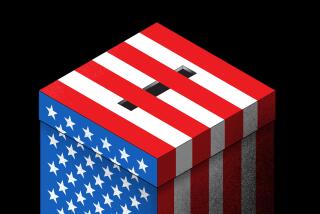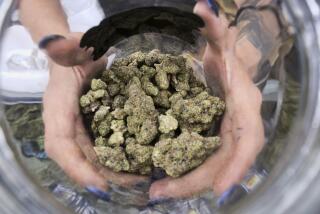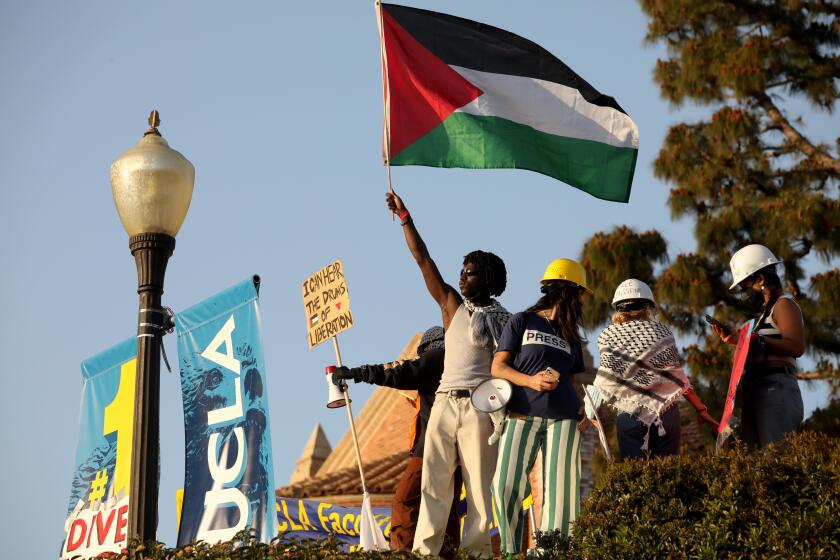This Election Just Might Register With Young Voters
Four years ago, Chris Rowlett was old enough to vote in the presidential election, but didn’t bother to register.
Last week, despite a biting early fall wind, the 22-year-old senior was standing in a line of students clustered around a voter registration table in the Diag, the campus crossroads at the University of Michigan.
“Before, I didn’t think who was in power mattered so much,” Rowlett said as he completed his registration form. “But things are changing so much more quickly now that it’s important who is in charge.”
Voters like Rowlett could be one of the wild cards in this year’s election. Though the participation rate among young people has dropped almost without interruption since the voting age was dropped to 18 from 21 in 1972, this year a panorama of nonpartisan and political groups are mounting well-funded efforts to register and turn them out. And with the war in Iraq and anxiety about the job market as the backdrop, they are finding a receptive audience among potential new voters such as Rowlett.
The principal coalition of nonpartisan groups targeting young voters -- an alliance including groups founded by hip-hop moguls Sean “P. Diddy” Combs and Russell Simmons to Rock the Vote, the New Voters Project and registration drives affiliated with MTV and World Wrestling Entertainment -- is aiming to increase the turnout among 18- to 30-year-olds from 18 million in 2000 to 20 million this year.
Young people have been courted with concerts, conferences and even an animated MTV video featuring video game characters, such as Tomb Raider Lara Croft. Combs, with more enthusiasm than subtlety, is promoting “Vote or Die” T-shirts. Filmmaker Michael Moore has embarked on a “slacker uprising” speaking tour on campuses, urging students to oppose President Bush. Both the Republican and Democratic parties are aggressively organizing students as well.
“There are more people spending more time and more resources in a better informed way on the task of youth voter mobilization this year than in a very long time,” said William Galston, director of the Center for Information and Research on Civic Learning and Engagement (CIRCLE) at the University of Maryland.
For the presidential campaigns, more young voters means, above all, more uncertainty.
Older voters may commonly assume that younger ones lean left. But since 1972, young voters have typically divided in numbers close to the overall national outcome, according to Voter News Service exit polls. Indeed, the youth vote has sided with the winner of the popular vote in every presidential election since President Reagan’s reelection in 1984.
In this campaign, they are proving an unpredictable force. Polls earlier this year generally gave Sen. John F. Kerry substantial leads among young people. But more recently, several surveys show Bush and his Democratic rival running step-for-step among them.
This suggests that young people, many of whom lack deep attachments to either side, could be one of the key constituencies that tilts the race -- especially if they turn out in the larger numbers that now seem possible.
“There is certainly a lot of fluidity; it is the nature of it with young voters,” said Ivan Frish berg, communications director of the nonpartisan New Voters Project. “Which is one of the reasons campaigns are nervous.”
The history of efforts to mobilize young voters is mostly a story of disappointment.
Despite a succession of high-profile campaigns, many of them glittering with celebrity endorsements, many young voters have stayed away from the polls since the 1970s.
Just more than half of Americans 18 to 24 years old turned out in 1972. But since then, no more than 46% of this age group have voted in presidential races; in 2000, the number was down to 42%, according to CIRCLE.
But this year, experts see signs that young people may be tuning in more closely than in any election since 1992, when their turnout rate hit a post-1972 peak. Recent polling by the nonpartisan Pew Research Center for the People & the Press found that nearly three-fifths of voters younger than 30 said they have given a lot of thought to this year’s election and had registered to vote, the highest levels since 1992.
That mood was evident at the University of Michigan as the deadline approached for registering in that state. Volunteers from the student government’s Voice Your Vote campaign unfolded a green ironing board with blue spots on a corner of the Diag, and then drew enough of a crowd all day that students were frequently waiting in line to register.
By day’s end, the volunteers had registered enough students to push the campaign’s total for the year past 10,000, almost one-fourth of the entire campus.
Lisa Canty, a freshman from nearby Milford, Mich., had filled out voter registration forms three times but left them sitting in her dorm room. When she saw the sign in the Diag announcing the opportunity to register, she decided to sign up.
“I wanted to have a say,” she said. “I didn’t want people to choose for me.”
Students and political analysts alike agree that young people are more engaged this year largely because the choices in the election seem more directly relevant to their lives.
The war in Iraq is a flashpoint, with some backing Bush and others worrying about the possibility of a draft. Slow job growth has many concerned about their prospects after graduation. And many students have concluded that their vote may be more influential than they thought after the 2000 election’s photo-finish.
“The excuse I used to get is, ‘My vote doesn’t make a difference,’ ” said Ramya Raghavan, a junior who is the chairwoman of the campus College Democrats chapter. “Now we can say: ‘Are you sure?’ ”
An unprecedented level of money and effort is attempting to convert this heightened interest into actual participation at the polls.
In a memo released last week, the six nonpartisan efforts that have joined in the “20 million loud” campaign said they were devoting a combined $40 million to registration and turnout drives.
In a separate effort, the College Republican National Committee, with a budget of more than $10 million, has dispatched 60 organizers to campuses around the country. College Democrats don’t have nearly that level of resources, but are working through state-coordinated campaigns to expand campus turnout.
Other efforts are also catching young people in their nets. Organizers for the political action committee affiliated with pro-Democratic MoveOn.org have been recruiting hundreds of volunteers for get-out-the-vote drives at anti-Bush rock concerts that began last week in several battleground states.
Although many of those attending the concerts have been in their 30s or older, Trevor Laird, a MoveOn organizer, said the onstage testimonials from rock stars such as Bruce Springsteen and Dave Matthews have boosted their recruiting efforts.
“They give us so much credibility,” Laird said as he enlisted volunteers at the show by Springsteen and R.E.M. in Detroit on Oct. 3. “With so many young people, they help us get just a minute of their attention.”
Given all this effort, “if the 18-to-29 year-old vote doesn’t tick up significantly this year, then we really have to go back to the drawing board,” said Galston, a former domestic policy advisor in the Clinton White House.
Just three weeks before election day, it remains uncertain which candidate would benefit from a big turnout among young voters.
Gallup Polls this year consistently have shown Kerry leading among young voters by at least 10 percentage points, and Kerry has also led narrowly in surveys sponsored by CIRCLE and MTV.
But Bush led among younger voters in the most recent Times poll. And recent Pew, ABC/Washington Post and Newsweek surveys showed young voters dividing about evenly between the two candidates.
Since most surveys include only a small sample of young people, random polling variation explains part of that divergence. But it may also reflect the fragility of views among young people.
In conversations at Michigan, both Kerry and Bush had strong supporters, with attitudes toward the war in Iraq often the dividing line.
At this left-leaning campus, many students criticized Bush’s foreign policy. Though Rowlett wasn’t as critical of the war as many others, he still intended to vote for Kerry because he believes Bush has damaged America’s image around the world.
Yet when the local College Republicans set up a table last week, they also attracted a steady flow of students who expressed support for Bush’s conservative social views and hawkish defense positions. “There are a lot more Republicans here than I thought,” said Jennifer Lixey, a freshman from Tawas City, Mich.
Compared with the older population, there also appear to be a lot more voters on campus who simply haven’t decided. Canty was one of them.
She would like to bring home the troops from Iraq, “but then that means the job is half done.” She leans more toward the Republicans but wasn’t impressed by Bush in his first debate with Kerry. Her choice in the election was the same as her choice of major: undecided.
“In case you can’t tell,” she said, “that’s a major theme in my life right now.”
Times staff writer Kathleen Hennessey contributed to this report.
More to Read
Get the L.A. Times Politics newsletter
Deeply reported insights into legislation, politics and policy from Sacramento, Washington and beyond. In your inbox three times per week.
You may occasionally receive promotional content from the Los Angeles Times.






